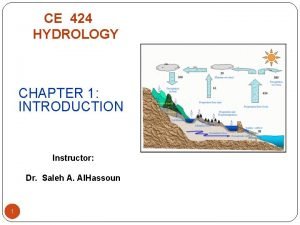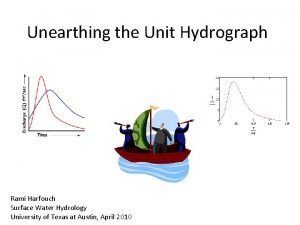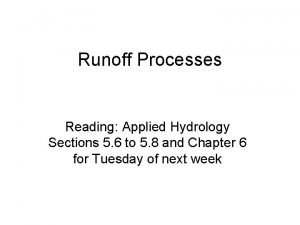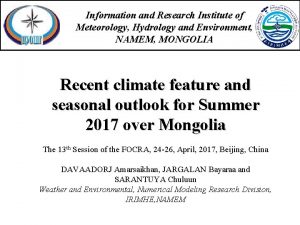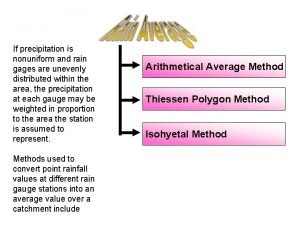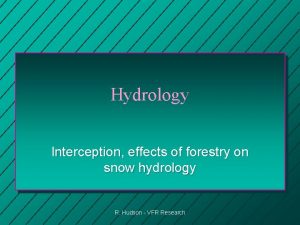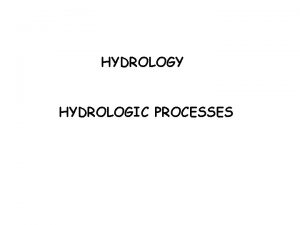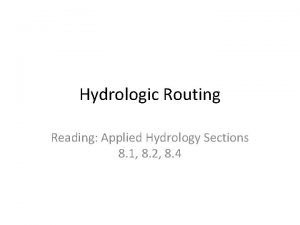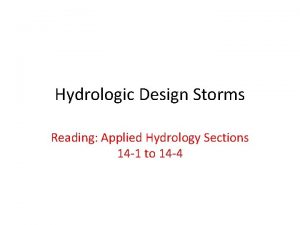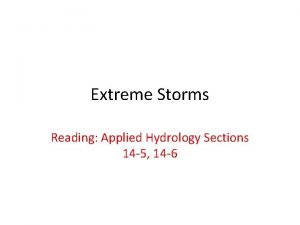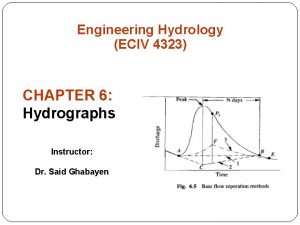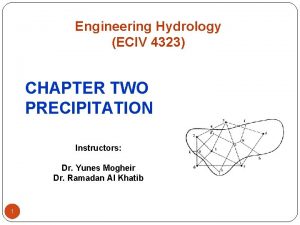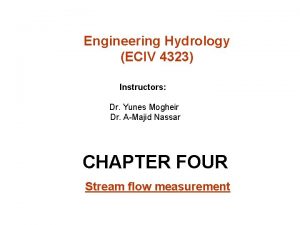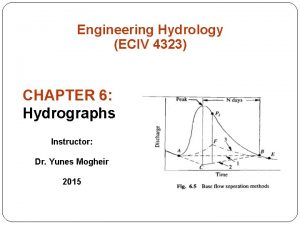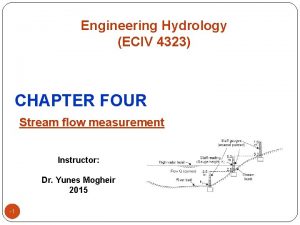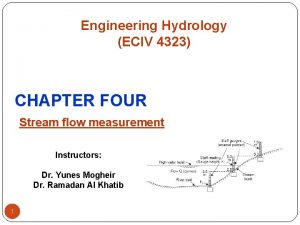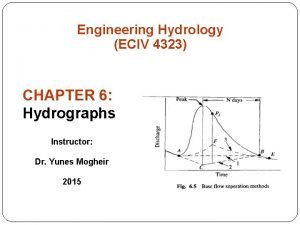Engineering Hydrology ECIV 4323 CHAPTER 1 INTRODUCTION Instructors













- Slides: 13

Engineering Hydrology (ECIV 4323) CHAPTER 1: INTRODUCTION Instructors: Dr. Yunes Mogheir Dr. Ramadan Al Khatib 1

1. 1 Introduction - Hydrology is the science of water: - - - 2 It is the science that deals with the occurrence, circulation, and distribution of water of the earth and earth’s atmosphere. It is concerned with water in streams and lakes, rainfall and snowfall, snow and ice on the land, and groundwater. It is of inter-disciplinary nature.

… 1. 1 Introduction In general, hydrology deals with Estimation of water resources. The study of processes such as precipitation, runoff, evapotranspiration and their interaction. The study of problems such as floods and droughts and strategies to combat them. 3

1. 2. Hydrologic Cycle 4

- Hydrologic Cycle Processes Atmospheric water Precipitation Evaporation Infiltration Land Surface Water Soil water Surface Runoff Groundwater Recharge (Percolation) Baseflow Groundwater System 5

1. 3. Water Budget Catchment Area or Watershed? Catchment area or drainage basin or river basin or watershed is defined as: The area drained by a stream or a system of connecting streams such that the surface runoff originating in this area leaves the area in concentrated flow through a single outlet. Catchment boundary or watershed or divide for the site At A Catchment boundary for the site At B Stream Outlet A Or Station A Stream Outlet B Tributary 6

Water budget equation System Concept Hydrologic analysis for various applications and models begins with the system concept. System Boundary INPUTS SYSTEM OPERATORS OUTPUTS Vi – V 0 = S I - Q = S/ t (change in storage with respect to time) 7 I = inflow volume per unit time Q = outflow per unit time

Typical Water Budget System Components P E P = precipitation E = evaporation T = transpiration R = Surface runoff G = net groundwater flow S = change in storage T R G P - R - G - E - T = S - Example 1. 1 and 1. 2 8

1. 4. World Water Balance Oceans Saline water on land Fresh: Groundwater 96. 5 % of total 1% of total 2. 5 % of total 30. 1 % of fresh water Polar Ice 68. 6 % of fresh water Lakes & Rivers 0. 266 % of fresh water Check tables 1. 1 and table 1. 2 in your text book 9

Global Water Balance (Table 1. 2 in textbook) Global Average Precipitation (per year): Ocean (70. 8 %) and Land (29. 2%) 127 cm x 0. 708 + 80 cm x 0. 292 = 113. 2 cm/yr Global Average Evaporation (per year): 140 cm x 0. 708 + 48. 4 x 0. 292 = 113. 2 cm/yr 10

1. 6. Application in Engineering ►We need hydrology in the design and operation of water resources engineering projects such as those for irrigation, water supply, flood control, water power and navigation. More specific examples: - The capacity of storage structures such as reservoirs - The magnitude of flood flows to enable safe disposal of excess flow - Floodplain analysis and delineation - The minimum flow and quantity of flow available at various seasons - Erosion and sediment control - The interaction of the flood wave and hydraulic structures, such as levees, reservoirs, and bridges ►The hydrologic study should of necessity precede structural and other detailed design studies. 11

1. 7. Sources of Data The data normally required: - Weather records ( temperature, humidity, wind velocity) - Precipitation data - Stream-flow records - Evaporation and transpiration data - Infiltration characteristics of the area - Groundwater characteristics - Physical and geological characteristics 12

Assignments for Chapter 1 Solve the following problems: - 1. 3 - 1. 5 13
 A small catchment of area 150 ha
A small catchment of area 150 ha How can instructors use the cone of experience
How can instructors use the cone of experience Applied hydrology
Applied hydrology Applied hydrology
Applied hydrology Meteorology hydrology and water management
Meteorology hydrology and water management Arithmetic mean rainfall
Arithmetic mean rainfall Hydrology test answers
Hydrology test answers Drh in hydrology
Drh in hydrology Interception hydrology
Interception hydrology Applied hydrology
Applied hydrology Hydrologic routing
Hydrologic routing Hyteograph
Hyteograph Applied hydrology
Applied hydrology Drh in hydrology
Drh in hydrology
